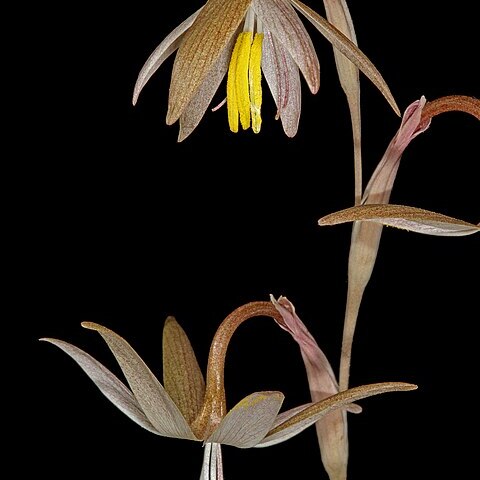Cormous geophyte, up to 300 mm high. Leaves 5 or 6, 2 basal, linear, 3 or 4 upper ones reduced in size. Flowers: laxly spaced, nodding, in a few-flowered spike; bracts erect to patent; perianth tube curved, 18-30 mm long with a reddish tinge, segments wine-red and white; Aug., Sep.
Flowers down-curved, whitish to ivory or light-brown, usually darker on the reverse of the outer tepals; perianth tube 18–25 mm long, much exceeding the bracts; tepals 14–18 × 5–6 mm, lanceolate, the inner slightly smaller than the outer.
Foliage leaves 5–6, the lower 2–3 basal, from half to about as long as the stem, erect or trailing, c. 2 mm wide, linear, the upper 1–2 leaves cauline, shorter than the basal ones and partly to entirely sheathing.
Spike 3–6(9)-flowered, secund; floral bracts green to membranous with darker veins, 12–25 mm long, the outer with the margins united around the stem for 1–2 mm, inner bract shorter or longer than the outer.
Cormous herb, up to 300 mm tall. Perianth tube curved, 20-30 mm long with a reddish tinge. Spike few-flowered with flowers laxly spaced. Flower bracts erect to patent. Flowers wine-red and white.
Corms c. 10 mm in diameter, campanulate; tunics dark-brown, irregularly serrate on the basal margin, the outer layer often irregularly broken.
Capsules 10–12 mm long, narrowly ovoid to oblong, enclosed within the bracts, dehiscing in the upper third.
Style branches 10–12 mm long, exceeding the anthers.
Anthers yellow to brown, (6)8–10 mm long, pendent.
Stem erect, rarely with a branch from the base.
Plants 30–50(70) cm high.

